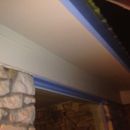Should I add more venting to my attic, or seal it up, or do nothing?
Should I add more venting to my attic, or should I seal it up and run a dehumidifier to prevent mold, or should I do nothing, or should I go with some fourth option? I read the “All about attic venting” article, but it doesn’t leave me certain about how I should proceed.
GENERAL DETAILS: My home was built in 1965, is in climate zone 2A (Austin TX), has 2000sf of attic floor covered with blown-in insulation, and has a sheet-metal roof covering an asphalt-shingle roof with no insulation above the sheathing or between the rafters.
VENTILATION DETAILS: There is a 4sf gable vent on the north side, and a 0.8 sf vent on the south side. Yes, that’s barely any venting. I presume that prior to a 2F addition in 1982, there was another 4sf gable vent on the south side. There are no soffits (see picture), so no easy way to add intakes there. There is no ridge venting.
MOISTURE DETAILS: There is no basement. No bath fans vent into the attic. No special efforts were made by the previous owner to seal up the ceiling penetrations but I intend do, though the roof is pitched so low I won’t be able to get to the edges to seal the top plates to the drywall there. The attic has leaky ducts but I plan to install a heat-pump minisplit system and seal up the registers and return.
I wouldn’t be venting to lower cooling bills or keep the attic dry, since I know venting won’t do that. If I vent, it would be to keep air circulating through because stagnant air is conducive to mold. However, I observed no mold in the attic, so if mold hasn’t been growing there over 51 years then it’s likely not a concern–and that even if mold formed, if it were confined to the attic, it’s probably not a health risk for the occupants. Perhaps I can go one step further and just seal the attic up completely to keep moist air out, then run a dehumidifier to keep it dry. Once the attic is dried out, I assume it should stay dry enough that the dehumidifier won’t kick in very often so I wouldn’t be using much electricity to power it.
So, should I add more venting to my attic, or should I seal it up and run a dehumidifier to prevent mold, or should I do nothing, or should I go with some fourth option?
GBA Detail Library
A collection of one thousand construction details organized by climate and house part










Replies
If it were my house, I would want to air seal and insulate to bring the attic inside the conditioned space. While you are interested in mini splits, they are not always a good fit for some homes.
Have you contacted the Austin government and Austin Energy to investigate incentives and rebates? Both entities may have programs that would inform your decision making process and help to offset your costs. For example, an energy audit would provide a baseline for understanding how your home is performing as-is and identifying good areas for making improvements.
In an Austin TX climate (like most of zone 2A,) venting the attic to the humid outdoors in summer adds more moisture into the structural wood in the attic than it removes. Wintertime moisture drives from the conditioned interior are relatively low compared to zone 4A and higher- don't even sweat the dehumidifier.
If the ducts are in the attic it's well worth insulating at the roof deck. To do that in a fully code-prescriptive manner would require a flash-inch of closed cell foam on the roof deck, but you can go with much cheaper fiber insulation below that. You don't need to remove the insulation on the attic floor other than to pull it back a couple of feet to really clean out over where the roof meets the attic joists so that the foam can make a good seal. Whatever the rafter depth, fill it completely (blown or batts), with no gaps, voids, or compressions.
What is your rafter depth?
How deep is the fluff on the attic floor?
Michael,
If you are going to install ductless minisplits, so that there are no longer any ducts in your unconditioned attic, there is no reason to try to convert your unconditioned attic to a conditioned attic.
If your attic has no existing moisture problems, there is no reason to believe that your attic will develop future moisture problems.
As Dana Dorsett correctly noted, venting an attic in your climate is often counterproductive (no matter what the code says). You've apparently read my "All About Attic Venting" article, so you know that.
So, relax. Don't add any more vents. Remember that the best measure to focus on is sealing air leaks between your conditioned space and the attic above.